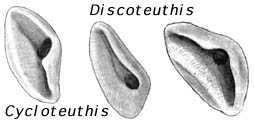Cycloteuthidae
Richard E. Young


This tree diagram shows the relationships between several groups of organisms.
The root of the current tree connects the organisms featured in this tree to their containing group and the rest of the Tree of Life. The basal branching point in the tree represents the ancestor of the other groups in the tree. This ancestor diversified over time into several descendent subgroups, which are represented as internal nodes and terminal taxa to the right.

You can click on the root to travel down the Tree of Life all the way to the root of all Life, and you can click on the names of descendent subgroups to travel up the Tree of Life all the way to individual species.
For more information on ToL tree formatting, please see Interpreting the Tree or Classification. To learn more about phylogenetic trees, please visit our Phylogenetic Biology pages.
close boxIntroduction
Cycloteuthids are mesopelagic squids of moderate size, the largest reaches about 60 cm ML, with a cosmopolitan distribution in tropical and subtropical waters (Nesis, 1982). In Cycloteuthis the mantle and fins are drawn-out into a slender tail. A tail is lacking in Discoteuthis and the large, oval (disc-like) combined fins extend virtually the full length of the mantle. Very little is known about the biology of any species in the family.
Brief diagnosis:
An oegopsid ...
- with triangular funnel locking-apparatus.
Characteristics
- Arms
- Arm suckers biserial.
- Buccal-crown connectives attach to ventral borders of Arms IV.
- Tentacles
- Tentacular club with quadraserial suckers.
- Tentacular club with quadraserial suckers.
- Funnel/mantle locking apparatus
- Funnel component with sub-triangular groove.
- Mantle component does not reach anterior mantle margin.
Comments
The genera are easily separated by body and fin shape (see title illustrations). In addition the presence of a large visceral photophore only in Cycloteuthis allows genera to be separated when badly damaged.
Nomenclature
A list of all nominal genera and species in the Cycloteuthidae can be found here. The list includes the current status and type species of all genera, and the current status, type repository and type locality of all species and all pertinent references.
Discussion of Phylogenetic Relationships
The feature that unites these two genera is the similar triangular shape of the funnel locking-apparatus. Other than this unusual feature, there is little morphological evidence for their close relationship. Molecular evidence (Carlini, 1998), however, supports their close relationship.
References
Carlini, D. B. 1998. The phylogeny of coleoid cephalopods inferred from molecular evolutionary analyses of the cytochrome oxidase I, muscle actin, and cytoplasmic actin genes. Ph.D. diss. Coll. William and Mary, 273 pp.
Nesis, K. N. 1982. Abridged key to the cephalopod mollusks of the world's ocean. 385+ii pp. Light and Food Industry Publishing House, Moscow. (In Russian.). Translated into English by B. S. Levitov, ed. by L. A. Burgess (1987), Cephalopods of the world. T. F. H. Publications, Neptune City, NJ, 351pp.
Young, R. E. and C. F. E. Roper. 1969. A monograph of the Cephalopoda of the North Atlantic: The family Cycloteuthidae. Smithsonian Contributions to Zoology No. 5:1-24.
Title Illustrations

| Scientific Name | Cycloteuthis serventyi, Discoteuthis discus (2) |
|---|---|
| Reference | Young, R. E. and C. F. E. Roper. 1969. A monograph of the Cephalopoda of the North Atlantic: The family Cycloteuthidae. Smithsonian Contributions to Zoology No. 5:1-24. |
| View | Ventral |
| Size | 42, 53 mm ML |
| Image Use |
 This media file is licensed under the Creative Commons Attribution-NonCommercial License - Version 3.0. This media file is licensed under the Creative Commons Attribution-NonCommercial License - Version 3.0.
|
| Copyright |
© Richard E. Young

|
About This Page
Richard E. Young

University of Hawaii, Honolulu, HI, USA
Page copyright © 2012 Richard E. Young
 Page: Tree of Life
Cycloteuthidae .
Authored by
Richard E. Young.
The TEXT of this page is licensed under the
Creative Commons Attribution-NonCommercial License - Version 3.0. Note that images and other media
featured on this page are each governed by their own license, and they may or may not be available
for reuse. Click on an image or a media link to access the media data window, which provides the
relevant licensing information. For the general terms and conditions of ToL material reuse and
redistribution, please see the Tree of Life Copyright
Policies.
Page: Tree of Life
Cycloteuthidae .
Authored by
Richard E. Young.
The TEXT of this page is licensed under the
Creative Commons Attribution-NonCommercial License - Version 3.0. Note that images and other media
featured on this page are each governed by their own license, and they may or may not be available
for reuse. Click on an image or a media link to access the media data window, which provides the
relevant licensing information. For the general terms and conditions of ToL material reuse and
redistribution, please see the Tree of Life Copyright
Policies.
- Content changed 10 November 2012
Citing this page:
Young, Richard E. 2012. Cycloteuthidae . Version 10 November 2012 (under construction). http://tolweb.org/Cycloteuthidae/19412/2012.11.10 in The Tree of Life Web Project, http://tolweb.org/








 Go to quick links
Go to quick search
Go to navigation for this section of the ToL site
Go to detailed links for the ToL site
Go to quick links
Go to quick search
Go to navigation for this section of the ToL site
Go to detailed links for the ToL site